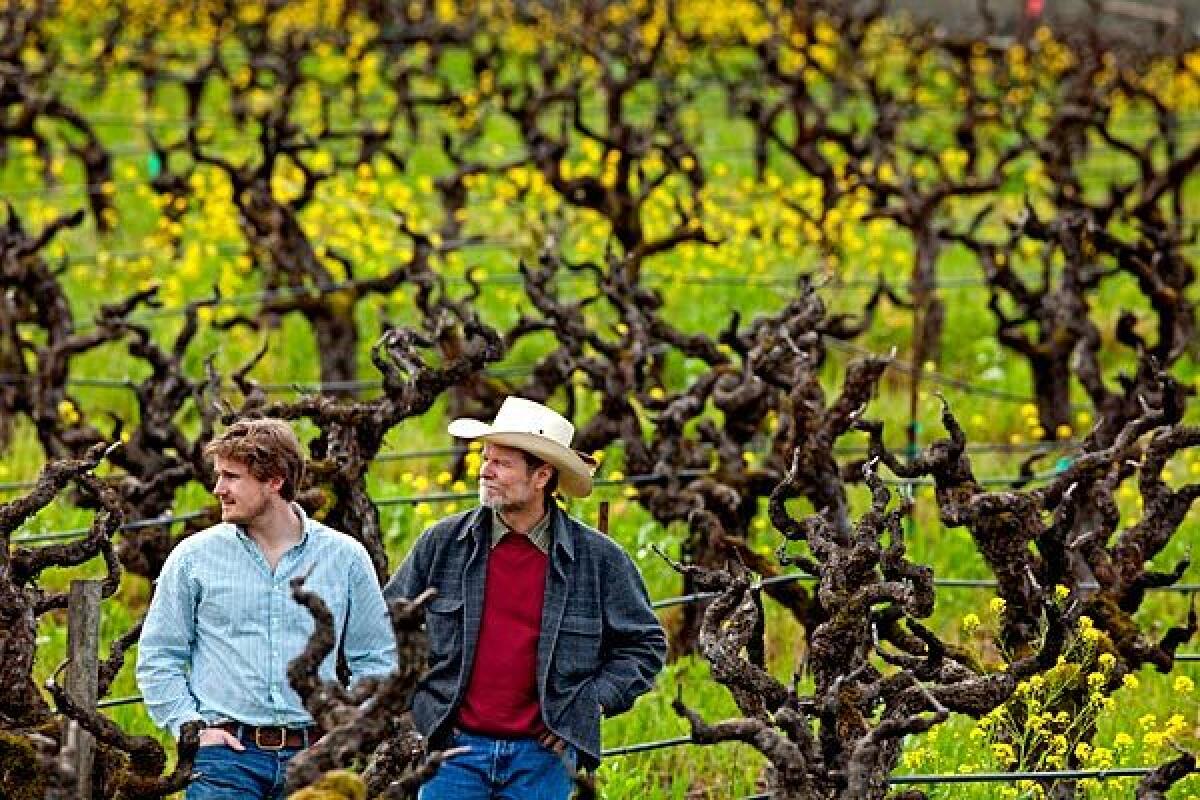When is a Zin not a Zin?

Zinfandel is often called California’s indigenous wine, but its story is not that simple. Some of the best Zinfandel-based wines from the state’s best and most historic vineyards can’t use the grape name on their labels.
In these bottles, Zinfandel leads a supporting cast of grapes in a traditional blend that is now outright discouraged — both by federal law and a skeptical market.
Those who love these wines say that while Zinfandel may be the star of these vineyards, it’s even better with a supporting cast. “Zinfandel’s like Beyoncé: She’s beautiful, she’s talented, but the women dancing behind her, they’re not bad either,” says JC Cellars winemaker Jeff Cohn.
The story goes back before Prohibition, but is causing controversy today. According to federal law, for a wine to be called Zinfandel or any other varietal name, it must contain at least 75% wine from that grape. The law is designed to protect consumers, but one consequence is that it has created several generations of American wine drinkers who believe a varietal wine is always better than a blend.
That’s certainly not the case when it comes to old-vine, single-vineyard Zinfandel. In fact, it’s a denial of California history. When these historic vineyards were planted a hundred years ago and more, grapes were almost never planted purely by variety. Zin was almost never planted by itself; it was planted in a mix of vines called a “field blend.”
A few of those vineyards endure, and they are a source of some of the most interesting — and authentically Californian — wines in the state.
“We’ve always found that the mixed vineyards are better than the straight Zinfandel vineyards,” says Ridge Vineyards vice president of vineyard operations David Gates. “They have greater depth of flavor. We pick all the grapes together and co-ferment them all together.”
Yet the biggest organization of Zinfandel producers in the state, Zinfandel Advocates and Producers, or ZAP, forbids wines not labeled “Zinfandel” from being poured at its events.
At a ZAP tasting in San Francisco in January, some of the state’s most famous wineries, including Ridge and Ravenswood, broke the group’s rules and poured field blends anyway.
“Field blends would be California’s main wine if it wasn’t for Prohibition,” says Ravenswood winemaker Joel Peterson. “This is a topic whose time has come.”
Until roughly the 1940s, when a wine industry reinventing itself after Prohibition broke from many past practices, vintners in California planned their final wines while planting their fields, choosing varieties that complement each other, as they do in Bordeaux with Cabernet Sauvignon and Merlot.
In a way, promoting field blends would mean switching to the European system of prizing specific terroirs rather than the American way, where the grape varietal is king.
In this state, Zinfandel historically was the main grape, valued for its large crops (from young vines), resistance to heat and cheerful red fruit flavors. But growers usually also planted Petite Sirah for body, Alicante Bouschet for color and thick handling-resistant skin, Carignane for perfumey high notes and any number of other grapes for various reasons, including simply to hedge their bet on what would ripen best. Some Italian American growers even planted a few Muscat vines so that pickers could snack on table grapes while they worked.
Most of those old field-blend vineyards have been grafted over multiple times to follow the whims of the varietal market. But a few have been maintained — mostly in Sonoma County — and are now a precious resource as they hold some of the oldest vines in the state. Older vines tend to yield more interesting wines, particularly when it comes to Zinfandel.
Joel Peterson and his son Morgan Twain-Peterson own one such vineyard, called Bedrock. Twain-Peterson, currently writing his Master of Wine dissertation on field blends, calls it one of the four greatest old vineyards in Sonoma Valley, along with Monte Rosso, Old Hill Ranch and Pagani Ranch.
Those vineyards are the source of some great wines: Ridge “Pagani Ranch” and Ravenswood “Old Hill” are two of my favorite Zin-based wines because of their complexity. But Bedrock has the most interesting history.
It was originally planted in 1854 by William Tecumseh Sherman and Joe Hooker, who would become better known in the next decade as Civil War generals. After the root louse phylloxera treated the grapevines like Sherman treated the South, in 1888 the vineyard was replanted by George Hearst, father of media mogul William Randolph Hearst.
Twain-Peterson says he has identified 18 grape varieties in the 152-acre vineyard, which his family bought in 2005, and he’s not sure he’s found them all yet. But the main grape is, of course, Zinfandel.
Peterson makes a Ravenswood wine labeled as Zinfandel from Bedrock Vineyard, and it’s excellent: great black cherry fruit, a pretty, perfumey aroma and a long finish.
But Twain-Peterson, proprietor of Bedrock Wine Co. at age 29, makes an even more interesting wine because he doesn’t separate the Zin grapes. Calling it “Bedrock Heirloom Wine,” Twain-Peterson estimates that it’s 50% Zinfandel, 25% Carignane and 25% “other stuff,” including Mourvedre, Syrah, Alicante Bouschet, Petite Sirah and whatever else looks ripe when the pickers arrive.
It’s a tremendous wine, spicy and complex, with red and black fruit flavors along with exotic notes of cinnamon and turmeric and a fascinating aroma that would put an expensive cologne to shame. Moreover, because it has a balance of tannin from some grapes and acidity from others, it will probably age well despite its hefty 15.5% alcohol.
“This is the quintessential California wine,” Twain-Peterson says. “No other country does this kind of wine.”
However, how is a consumer, without knowing the background, to tell the difference between Bedrock Heirloom Wine and a supermarket blend like Red Truck, made of grapes purchased from around the state? There’s no label law regulating “field blend,” and the term has no market traction anyway.
For that reason, Zin-based field blends are usually a hard sell, despite their heritage, complexity and deliciousness.
“There’s so many versions of what a field blend is so they don’t go over too well,” says Bob Golbahar, president of Twenty Twenty Wine Merchants. “People want to know what it is and what’s in there.”
ZAP is not rushing to support field blend producers. Its board of directors had a long, heated debate last year before ruling that promoting field blends — traditionally called “mixed blacks” by growers not only because that is what the grapes look like, but also because it saves the trouble of hiring a geneticist to figure out what they actually are — would detract from the group’s promotion of Zinfandel.
“ZAP has worked since 1991 to get people to figure out what Zinfandel is,” Twain-Peterson says. “In 1991, putting Zinfandel on a bottle of red wine was a step of courage. Mixed blacks are the next level of discussion.”
Fortunately for field blend fans, the past is not dying with the vines. Ridge is committed to replanting mixed blacks in its field-blend vineyards like Geyserville.
Mike Officer, owner of the mailing-list-only brand Carlisle, will replant Papera Ranch vineyard in Russian River Valley this year with a mix of mostly Zinfandel but also Petite Sirah, Alicante Bouschet, Carignane, Grenache — and even some Muscat vines for the pickers.
“We’re kicking it old school,” Officer says.
More to Read
Eat your way across L.A.
Get our weekly Tasting Notes newsletter for reviews, news and more.
You may occasionally receive promotional content from the Los Angeles Times.






